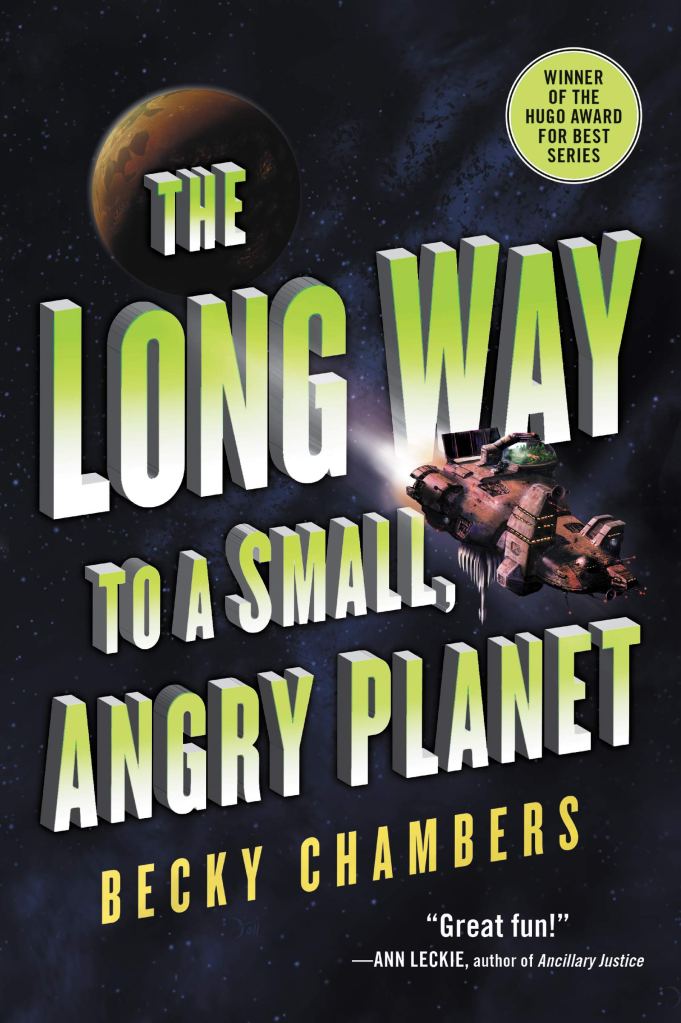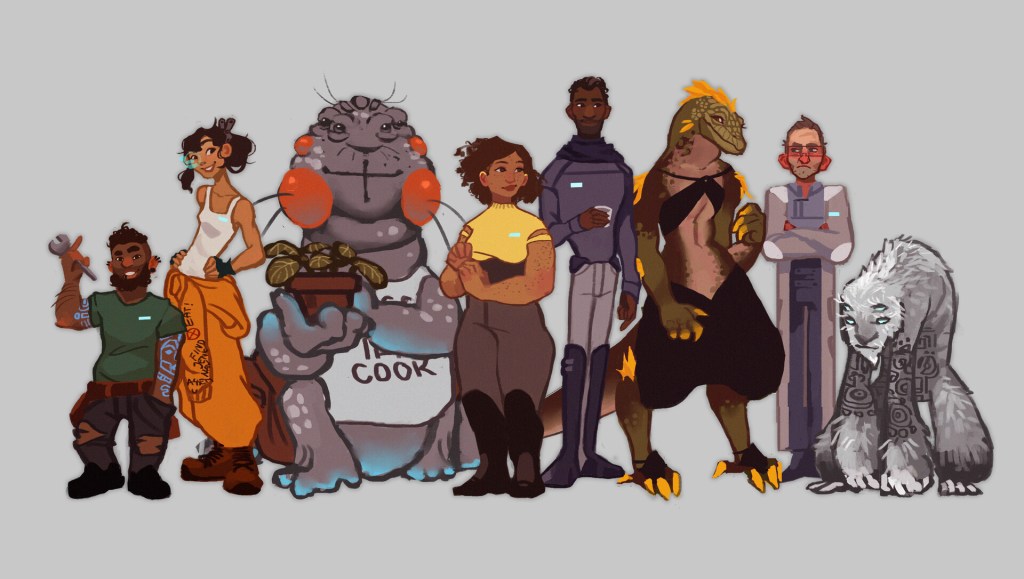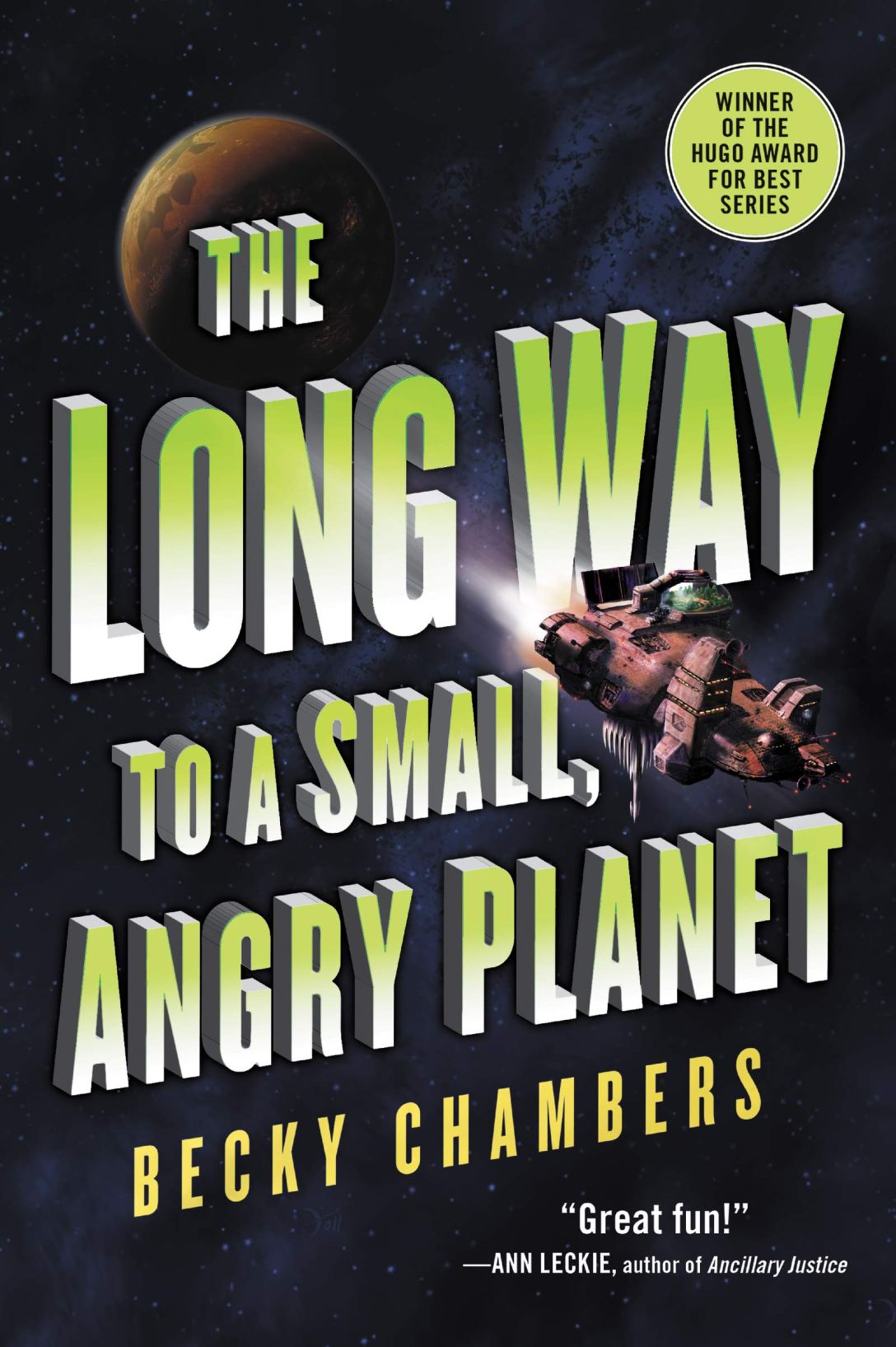
This is one of those books which does exactly what it says on the tin! The book does track the journey of the space ship The Wayfarer to Hedra Ka, a distant planet recently – and controversially – admitted to the Galactic Commons. And it is a long journey taking over a year (or a “standard”) to complete so we only reach Hedra Ka in Chapter 18 with only five chapters left thereafter.
What follows is basically an episodic introduction to the universe Chambers created: the fate of Earth (somewhat apocalyptic, leading to an exodus from the planet and either to Mars or into space), the Wayfarer crew, different species are introduced through those episodes and it is a gentle, fun trip with some moments of tension. The book carries echoes perhaps of Firefly in the motley patchwork ship and crew, bickering but working together effectively.
Chambers’ characters are very warm-hearted: Ashby, the captain of The Wayfarer, is gentle and benevolent managing his crew with an avuncular care rather than any military-style chain of command; the techs, Kizzy and Jenks, provide light relief which does not detract from the reader’s ability to empathise with them; Sissix’ warmth, Dr Chef bustling fussing care, Lovelace (or Lovey) the ship’s sentience AI – my second sentient space ship after Skyward – are all a lovely warm ensemble. The newcomer Rosemary slots herself into the crew rapidly despite hiding her own history from them; Corbin, the prickly algaeist, is the least likeable but perhaps has the more interesting arc.
Let’s take a look at the alien species because, in this aspect, I found the book a little… lazy. May uninspired is a better word than lazy. Sissix is an Aandrisk, a sentient humanoid lizard, the Quelin are described as “lobster centaurs”, and a Harmagian is a “mollusk-like blob who couldn’t move around quickly without the help of his cart. He didn’t have teeth or claws. He didn’t have bones.” Taking familiar Earth species and making them humanoid does seem familiar (any number of sci fi games do exactly the same) and uninspiring. Chambers even offers an in-universe comment
we Aandrisks do look like some of the native reptilian species of Earth. Humans do look like larger, bipedal versions of the hairless primates that plague the sewer systems of Quelin cities. Quelin do bear some resemblance to the snapping crustaceans found all over Hashkath. And yet, we evolved separately, and on different worlds. My people and the lizards of Earth do not share an evolutionary tree, nor do Humans and tiks, nor Quelin and sersh. Our points of origin are spread out across the galaxy. We hail from systems that remained self-contained for billions of years, with evolutionary clocks that all began at different times. How is it possible that when meeting our galactic neighbors for the first time, we are all instantly reminded of creatures back home — or in some cases, of ourselves?
There are, though some more imagined species: the Grum and Sianat – like Dr Chef and Ohan on The Wayfarer, respectively – are more interesting and thoughtful, but again the mythology of their cultures and histories felt a little superficially used.
In fact, “superficial” and “surface” feel like words I keep coming back to with this. I do love the image of the future which is (in the main) inclusive of difference and alienness and gender identities and sexuality – a world in which people (and the writer) seem generally to like and respect, well, people – which The Wayfarer offers. But there were a range of possible plot points and conflict that could lead to real character development, and they are managed and disposed of very swiftly. Rosemary, taking just one example from several, is introduced to us as a character on the run, carrying a potent secret, lying to her new crew. And that secret is exposed. And promptly glossed over. And nothing changes on board. Nothing. It was met with a general shrug and a rather preachy chapter where Dr Chef tells her
“All you can do, Rosemary — all any of us can do — is work to be something positive instead. That is a choice that every sapient must make every day of their life. The universe is what we make of it. It’s up to you to decide what part you will play. And what I see in you is a woman who has a clear idea of what she wants to be… You’re trying to be someone good.”
The messages in the book are all wonderful – we can find family anywhere, be kind and understanding of others, accept and celebrate and respect difference – but the execution… felt a little clunky and unpolished.
That said, I did enjoy the book and I did find the finale gripping (if a little predictable) – and, yes, there was a lump in my throat for an unexpected character. I will probably pick up the other books in the series, but they’re not jumping up my tbr list! It was, however, a lovely antidote to the increasing stress and tension rising in the real world at the moment and a welcome escape from coronavirus anxiety!
But finally, a wonderful piece of fanart from Elsa Varland of the crew!

RATINGS:
Overall:
Characters:
Plot / Pace:
Worldbuilding:
Structure:
Language:
Publisher: Hodder & Stoughton
Date: 31st December 2015
Available: Amazon; Hodder & Stoughton



Great review! I’ve been seeing this one pop up recently, I’ll have to check it out!!
LikeLiked by 1 person
Thank you! It was a decent enough read! Hope you’re staying safe and well
LikeLiked by 1 person
[…] shortlist just before the shutdown – along with The Mercies, The Lost Future of Pepperharrow, The Long Way to a Small, Angry Planet and a dozen […]
LikeLike
[…] system to try to join the Superiority; the gorilla-like burl; the UrDail. Recently, I reviewed The Long Way To A Small Angry Planet and I grumbled that the aliens were just large humanoid versions of earth animals and the same […]
LikeLike
[…] The Long Way To A Small, Angry Planet, Becky Chambers […]
LikeLike
[…] behind varying degrees of coarseness. They did remind me a little of the crew of the Wayfarer in The Long Way to a Small Angry Planet – a family more than a crew perhaps – a replacement for the mother lost to Aleja. It is […]
LikeLike
[…] The Long Way to a Small Angry Planet, Becky Chambers […]
LikeLike
[…] The Long Way to a Small Angry Planet, Becky Chambers […]
LikeLike
[…] The Long Way To A Small Angry Planet, Becky Chambers […]
LikeLike
[…] At its heart, however, this novel is about the joy and magic and wonder of being part of a family, the joy of loving and realising that you are worth receiving love – whether that be the familial love that the children offer Linus or the romantic love Arthur offers. In this way, it reminded me a lot of Becky Chambers’ The Long Way To A Small Angry Planet. […]
LikeLike
[…] have only read the first of The Wayfarers series, to be fair, but I did love it and whilst I doubt I’ll have caught up by February, […]
LikeLike
[…] The Long Way to a Small Angry Planet […]
LikeLike
[…] and Jenks, The Long Way to a Small, Angry Planet, Becky […]
LikeLike
[…] a rousing name check to Cinderella Is Dead, The Long Way to A Small, Angry Planet, One Last Stop, Aristotle and Dante Discover the Secrets of the Universe, The Black Flamingo and […]
LikeLike
[…] The Long Way to a Small Angry Planet, Becky Chambers […]
LikeLike
[…] A Long Way to a Small, Angry Planet, Becky Chambers 665 views […]
LikeLike
[…] dip into often, but I generally do enjoy it when I do! There are quirky, heartwarming writers like Becky Chambers or the glorious weirdness that is Tamsyn Muir’s Locked Tomb and even the lyricism of This Is […]
LikeLike
[…] Chambers’ brand of cheering space opera in The Long Way to a Small Angry Planet is so endearing that the chance to see her imagination in a new setting is exciting – and, […]
LikeLike
[…] year I made a real effort to discover more in Becky Chambers’ Wayfarers series and Tchaikovsky’s Shards of Earth and the riotous fun of Gideon the Ninth… what […]
LikeLike
[…] The Long Way to a Small Angry Planet, Becky Chambers […]
LikeLike
[…] The Wayfarers series, Becky Chambers […]
LikeLike
[…] Chambers came across my reading radar with The Long Way to a Small Angry Planet and her Wayfarers series is a wonderful warm science fictiony hug! Yes there were traditional space […]
LikeLike
[…] discovery during lockdown for me, along with T. J. Klune and Casey McQuiston. Her Wayfarers series, The Long Way to a Small Angy Planet and A Closed and Common Orbit and its sequels, and her Monk and Robot series that begins with A […]
LikeLike